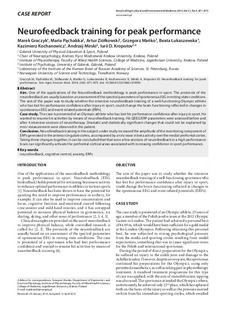| dc.contributor.author | Graczyk, Marek | |
| dc.contributor.author | Pachalska, Maria | |
| dc.contributor.author | Ziolkowski, Artur | |
| dc.contributor.author | Manko, Grzegorz | |
| dc.contributor.author | Lukaszewska, Beata* | |
| dc.contributor.author | Kochanowicz, Kazimierz | |
| dc.contributor.author | Mirski, Andrzej | |
| dc.contributor.author | Kropotov, Yury | |
| dc.date.accessioned | 2019-10-31T11:43:41Z | |
| dc.date.available | 2019-10-31T11:43:41Z | |
| dc.date.created | 2015-01-15T15:47:33Z | |
| dc.date.issued | 2014 | |
| dc.identifier.citation | AAEM: Annals of Agricultural and Environmental Medicine. 2014, 21 (4), 871-875. | nb_NO |
| dc.identifier.issn | 1232-1966 | |
| dc.identifier.uri | http://hdl.handle.net/11250/2625575 | |
| dc.description.abstract | Aim:
One of the applications of the Neurofeedback methodology is peak performance in sport. The protocols of the neurofeedback are usually based on an assessment of the spectral parameters of spontaneous EEG in resting state conditions. The aim of the paper was to study whether the intensive neurofeedback training of a well-functioning Olympic athlete who has lost his performance confidence after injury in sport, could change the brain functioning reflected in changes in spontaneous EEG and event related potentials (ERPs).
Case study:
The case is presented of an Olympic athlete who has lost his performance confidence after injury in sport. He wanted to resume his activities by means of neurofeedback training. His QEEG/ERP parameters were assessed before and after 4 intensive sessions of neurotherapy. Dramatic and statistically significant changes that could not be explained by error measurement were observed in the patient.
Conclusion:
Neurofeedback training in the subject under study increased the amplitude of the monitoring component of ERPs generated in the anterior cingulate cortex, accompanied by an increase in beta activity over the medial prefrontal cortex. Taking these changes together, it can be concluded that that even a few sessions of neurofeedback in a high performance brain can significantly activate the prefrontal cortical areas associated with increasing confidence in sport performance. | nb_NO |
| dc.language.iso | eng | nb_NO |
| dc.publisher | Ministry of Science and Higher Education, Republic of Poland | nb_NO |
| dc.rights | Navngivelse-Ikkekommersiell 4.0 Internasjonal | * |
| dc.rights.uri | http://creativecommons.org/licenses/by-nc/4.0/deed.no | * |
| dc.title | Neurofeedback training for peak performance | nb_NO |
| dc.type | Journal article | nb_NO |
| dc.type | Peer reviewed | nb_NO |
| dc.description.version | publishedVersion | nb_NO |
| dc.source.pagenumber | 871-875 | nb_NO |
| dc.source.volume | 21 | nb_NO |
| dc.source.journal | AAEM: Annals of Agricultural and Environmental Medicine | nb_NO |
| dc.source.issue | 4 | nb_NO |
| dc.identifier.doi | 10.5604/12321966.1129950 | |
| dc.identifier.cristin | 1198906 | |
| dc.description.localcode | Open Access CC-BY-NC | nb_NO |
| cristin.unitcode | 194,67,40,0 | |
| cristin.unitname | Institutt for psykologi | |
| cristin.ispublished | true | |
| cristin.fulltext | original | |
| cristin.qualitycode | 1 | |

